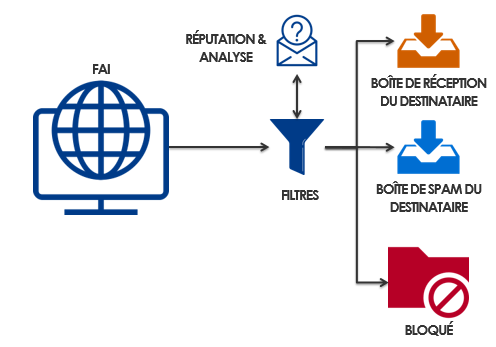Beim Einrichten eines IP-Setups für den Versand von Mailings über ein E-Mail-Marketing System stellt sich die Frage nach der Verwendung eines gemeinsamen IP-Pools für mehrere Versender (shared IPs) oder der dedizierten Nutzung eigener IPs für nur einen Versender. Beides hat Vor- und Nachteile für den Sender und sollte entsprechend durchdacht werden.
WhatsApp ist die Neue E-Mail…
… das war eine der Thesen der letzten Jahre. “Facebook verdrängt E-Mail” eine andere. In der Tat hat sich viel persönliche Kommunikation von der E-Mail in Richtung Messenger bewegt. Dennoch ist Facebook einer der größten E-Mail Versender weltweit. Ein Widerspruch? Nein. Vielmehr ist E-Mail ist gute und sinnvolle Verbindung und Erweiterung der neuen und klassischen Kanäle.

We could talk about Deliverability as everyone, we choose to talk about it as no one.
Today, more than 60% of the whole email traffic is spam (statistica, 2016). This means ISPs have more chance to receive a spam attack, or a risk to his customer, than an important emailing.
Your ISP can proudly show it has a 99% Deliverability rate, nevertheless evidently you receive your emails in the junk folder, or you are blocked to a specific ISP. How can this be? Why is my Deliverability so high on some ISPs and not on all ISPs? Why do I have 99% Deliverability rate but the ISPs still consider me as a spammer? The indicators are just not calculated the same way…
Das Thema Zustellbarkeit („Deliverability“) wird bei Werbetreibenden oft automatisch mit dem Kanal „E-Mail“ assoziiert. Aber wie sieht es mit den anderen Kanälen, wie Facebook oder Mobile Push aus? Spielt Zustellbarkeit hier ebenfalls eine Rolle? Wie unterscheiden sich die Kanäle überhaupt? Dieser Artikel behandelt diese Punkte und gibt praktische Ratschläge.

There have been many articles and myths circulated about Spamtraps and honeypots. Are they following URLs in E-mails or can you identify them by suppressing the inactive ones? What exactly is their purpose? What can you do if you have identified spamtraps in your list and how can you get rid of them?
There are various types of Spamtraps testing different kinds of (bad) behaviour and therefore acting differently. Main types are pristine (only created for the purpose of being a spamtrap) and recycled (those have been an existing address before).
Stellt euch vor: seit nunmehr 11 Stunden sitze ich im Flieger und trete meinem wohlverdienten Urlaub an. Wenn ich mich umschaue, sehen alle müde und abgekämpft aus. Gut, das kann auch daran liegen, dass wir uns nicht in den ersten Reihen befunden haben. Keine Alk Flat, kein Liegesitzsessel, keine Rundumsorglos Behandlung, sondern nur Plastikbecher und -besteck.